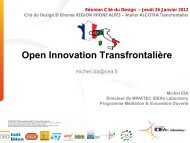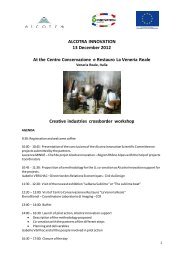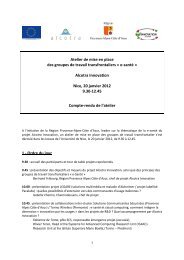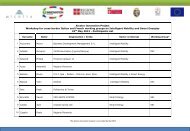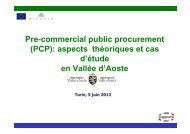Best practices Database for Living Labs - ALCOTRA - Innovation
Best practices Database for Living Labs - ALCOTRA - Innovation
Best practices Database for Living Labs - ALCOTRA - Innovation
You also want an ePaper? Increase the reach of your titles
YUMPU automatically turns print PDFs into web optimized ePapers that Google loves.
10. ENoLL evaluation criteria<br />
In the <strong>Database</strong> only <strong>Living</strong> Lab data is stored from <strong>Living</strong> <strong>Labs</strong> which have been approved to join the ENoLL<br />
<strong>Living</strong> Lab Network. The approval process is conducted almost every year, meaning that there is a <strong>for</strong>mal<br />
evaluation of <strong>Living</strong> Lab applications <strong>for</strong> the ENoLL Network. This Evaluation is done by <strong>Living</strong> Lab experts<br />
from all around Europe, Francesco Molinari and Jens Schumacher have also been acting as reviewer as well<br />
as Lead-reviewer <strong>for</strong> this process. The goal of this <strong>Living</strong> Lab approval process is to ensure that <strong>Living</strong> <strong>Labs</strong><br />
can enter the EnoLL which are compliant according to the general concept of <strong>Living</strong> <strong>Labs</strong>. Thus the<br />
application does usually not provide a ranking but instead checks whether certain threshold values have<br />
been reached. As such all <strong>Living</strong> <strong>Labs</strong> can be considered to some extend <strong>Best</strong> <strong>practices</strong> since there is a<br />
reasonable high drop-out quote in the evaluation process. However the evaluation is only done on the<br />
bases of the documentation provided by the <strong>Living</strong> <strong>Labs</strong> to the Review team and there are some restrictions<br />
regarding the application <strong>for</strong>m, thus the evaluation is mainly a kind of “desk evaluation” meaning that the<br />
actual situation at the place where the <strong>Living</strong> Lab resides is not taken into account.<br />
11. Usage of the <strong>Database</strong><br />
As explained in the chapter about the ownership of the data the usage of the database and its content is<br />
currently restricted. In general the usage is only possible <strong>for</strong> researchers at FHV who would like to conduct<br />
e.g. statistical research on <strong>Living</strong> <strong>Labs</strong>. As such no GUI was developed to support the usage of the database<br />
but native SQL-commands (standard query language) can be used to search through the DB. The main<br />
usage of the database so far has been to identify similar thematic <strong>Living</strong> <strong>Labs</strong> in order to support other<br />
<strong>Living</strong> labs e.g. in the set-up of their activities, finding a good governance structure, identify methods <strong>for</strong><br />
user/citizen integration in <strong>Living</strong> <strong>Labs</strong>.<br />
The <strong>Database</strong> was used early on in the Alcotra project to identify a first set of <strong>Living</strong> <strong>Labs</strong> that are situated<br />
in a similar thematic context as defined by Alcotra in the in the workshops in Marseille and Genoa (see the<br />
following figure).<br />
The project is co-funded by the ERDF<br />
Page 65 of 78



